
Our Lady of Fátima is a Catholic title of Mary, mother of Jesus, based on the Marian apparitions reported in 1917 by three shepherd children at the Cova da Iria in Fátima, Portugal. The three children were Lúcia dos Santos and her cousins Francisco and Jacinta Marto. José Alves Correia da Silva, Bishop of Leiria, declared the events worthy of belief on 13 October 1930.

Caesaropapism is the idea of combining the social and political power of secular government with religious power, or of making secular authority superior to the spiritual authority of the Church; especially concerning the connection of the Church with government. Although Justus Henning Böhmer (1674–1749) may have originally coined the term caesaropapism (Cäseropapismus), it was Max Weber (1864–1920) who wrote that "a secular, caesaropapist ruler ... exercises supreme authority in ecclesiastic matters by virtue of his autonomous legitimacy." According to Weber, caesaropapism entails "the complete subordination of priests to secular power."

Blachernitissa, also called Theotokos of Blachernae or Our Lady of Blachernae, is a 7th-century encaustic icon representing the Most Holy Theotokos and Ever-Virgin Mary. It is also the name given to the Church built in honour of the Virgin Mary in the Blachernae section of Constantinople. The name Blachernae possibly derived from the name of a Vlach, who came to Constantinople from the lower Danube.

The Virgin of Vladimir, also known as Vladimir Mother of God, Our Lady of Vladimir, and the Theotokos of Vladimir, is a 12th-century Byzantine icon depicting the Virgin and Child and an early example of the Eleusa iconographic type. It is one of the most culturally significant and celebrated pieces of art in Russian history. Many consider it a national palladium with several miracles of historical importance to Russia being attributed to the icon. Following its near destruction in the thirteenth century, the work has been restored at least five times.

September 7 - Eastern Orthodox liturgical calendar - September 9

May 11 - Eastern Orthodox Church calendar - May 13
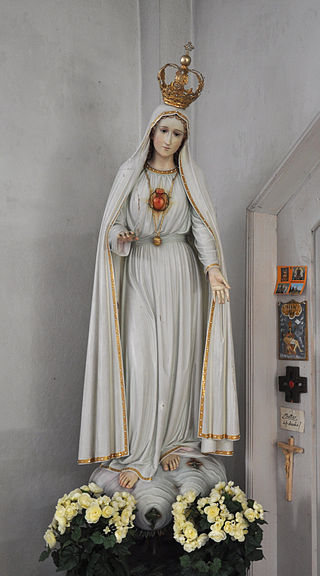
The consecration of Russia to the Immaculate Heart of Mary by a reigning pope was requested during a Marian apparition by Our Lady of Fátima on 13 July 1917, according to Lúcia dos Santos, one of the three visionaries who claimed to have seen the apparition. Sister Lucia said that at different times the Blessed Virgin Mary had given her a message of promise that the consecration of Russia to the Immaculate Heart of Mary would usher in a period of world peace.

Our Lady of Kazan, also called Mother of God of Kazan, is a holy icon of the highest stature within the Russian Orthodox Church, representing the Virgin Mary as the protector and patroness of the city of Kazan, and a palladium of all of Russia and Rus', known as the Holy Protectress of Russia. As is the case for any holy entity under a Patriarchate in communion within the greater Eastern Orthodox Church, it is venerated by all Orthodox faithful.

The Feodorovskaya Icon of the Mother of God, also known as Our Lady of Saint Theodore and the Black Virgin Mary of Russia, is the patron icon of the Romanov family. It is one of the most venerated icons in the Upper Volga region. Her feast days are March 14 (27) and August 29.

Ganina Yama was a 6 ft (2 m) deep pit in the Four Brothers mine near the village of Koptyaki, 15 km north from Yekaterinburg. In the pre-dawn hours of 17 July 1918, after the execution of the Romanov family, the bodies of Tsar Nicholas II of Russia and his family were secretly transported to Ganina Yama and thrown into the pit.
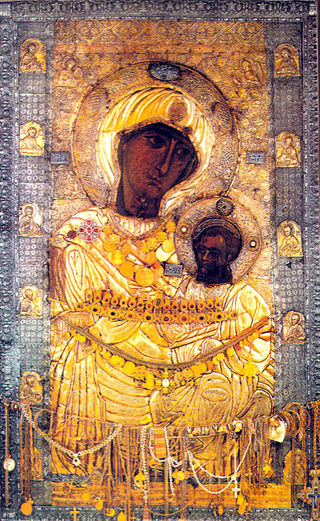
The Panagia Portaitissa also known as the Iviron Theotokos or Iverskaya in Russian, is an Eastern Orthodox icon of the Virgin Mary in the Georgian Iviron monastery on Mount Athos in Greece, where it is believed to have been since the year 999. According to the sacred tradition of the Eastern Orthodox Church it was painted by Luke the Evangelist. The icon is referred to as "Wonderworking" meaning that numerous miracles have been attributed to the intercession of the Theotokos by persons praying before it. The synaxis for this icon is on February 12, as well as on Bright Tuesday, and also on October 13 for the translation to Moscow of the Iveron icon.
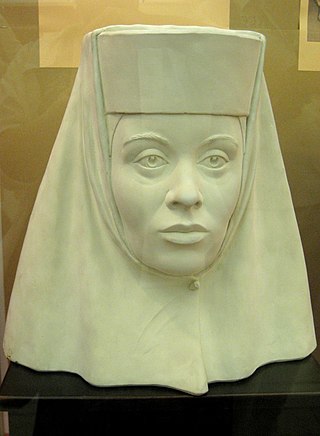
Irina Feodorovna Godunova, also known by her monastic name Alexandra (Александра), was the tsaritsa consort of all Russia by marriage to Feodor I from 1584 until his death on 17 January [O.S. 7 January] 1598. As her husband died childless, she was the de facto ruler of Russia until she retired to Novodevichy Convent nine days later. She remained the nominal ruler of Russia until her brother Boris Godunov was elected tsar on 3 March [O.S. 21 February] 1598.

The coronation of the emperor of Russia from 1547 to 1917, was a highly developed religious ceremony in which they are crowned and invested with regalia, then anointed with chrism and formally blessed by the church to commence his reign. Although rulers of Muscovy had been crowned prior to the reign of Ivan III, their coronation rituals assumed overt Byzantine overtones as the result of the influence of Ivan's wife Sophia Paleologue, and the imperial ambitions of his grandson, Ivan the Terrible. The modern coronation, introducing "Western European-style" elements, replaced the previous "crowning" ceremony and was first used for Catherine I in 1724. Since tsarist Russia claimed to be the "Third Rome" and the replacement of Byzantium as the true Christian state, the Russian rite was designed to link its rulers and prerogatives to those of the so-called "Second Rome" (Constantinople).

The Cincture of the Theotokos is believed to be a relic of the Theotokos, now in the Vatopedi monastery on Mount Athos, which is venerated by the Holy Eastern Orthodox Church. The word "cincture" is sometimes also translated as "belt", "sash" or "girdle". It is the Orthodox equivalent of the Girdle of Thomas in the Western church, and the Syriac Holy Girdle. Its feast day is September 13.
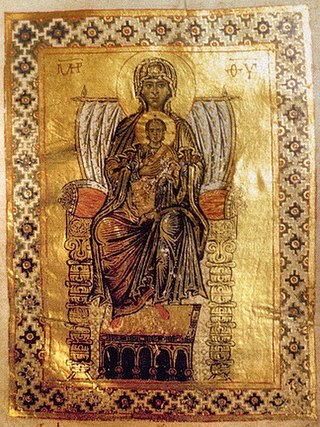
Panachranta is a type of icon in the Eastern Orthodox Church, that refers to the all immaculate Virgin Mary, the Theotokos.

Theotokos of Port Arthur is an Eastern Orthodox icon, representing the Theotokos with the Mandylion and God the Father, flanked by two angels. The icon's dimensions are approximately 124×77 cm. The icon is associated with the vision of an old veteran sailor, who came to pray in the Kiev Pechersk Lavra on December 11, 1903. In his dream, the sailor reportedly saw the Virgin Mary, who warned him about the upcoming Russo-Japanese War. Mary instructed to make an exact depiction of the vision and deliver it to Port Arthur so that the Russians would gain her patronage and protection in the war.

The Emperor and Autocrat of all Russia, also translated as Emperor and Autocrat of all the Russias, was the official title of the Russian monarch from 1721 to 1917.

December 25 – Eastern Orthodox liturgical calendar – December 27
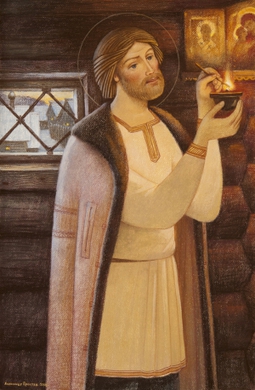
Davyd Yuryevich and Euphrosyne, known as Saints Peter and Fevronia of Murom, were the Russian prince and princess consort of the Principality of Murom. They are some of the most renowned Russian saints and wonderworkers venerated both in the Eastern Orthodox Church and the Eastern Catholic Church; their feast day is celebrated every year on 25 June, N.S..

The Panagia Ierosolymitissa icon of the Mother of God is an acheiropoieton located in the Tomb of Mary in Gethsemane in Jerusalem. The icon is considered by Orthodox Christians to be the patroness of Jerusalem. Although occasionally confused, the PanagiaIerosolymitissa icon is different than the Jerusalem Icon of the Mother of God.






















